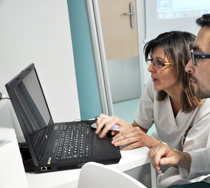Uso de las tecnologías de la información y las comunicaciones en la carrera de Enfermería
Palabras clave:
TECNOLOGÍA DE LA INFORMACIÓN, EDUCACIÓN EN ENFERMERÍA, EDUCACIÓN EN SALUD, TECNOLOGÍA BIOMÉDICA, DESARROLLO TECNOLÓGICOResumen
Introducción: las nuevas tecnologías favorecen el desarrollo científico técnico de la sociedad, por lo cual se deben asimilar en el proceso enseñanza aprendizaje por los estudiantes de la carrera.
Objetivo: caracterizar el uso de las tecnologías de la información y las comunicaciones por los estudiantes de la carrera Licenciatura en Enfermería de la Universidad de Ciencias Médicas de Pinar del Río entre enero y marzo de 2018.
Métodos: estudio observacional, descriptivo, y transversal en los estudiantes de segundo año de licenciatura en Enfermería. Se emplearon métodos teóricos y empíricos. Se aplicaron medidas estadísticas como frecuencia absoluta y relativa porcentual.
Resultados: se encontró que el 23,5 % no poseía acceso a ningún medio informático. La mitad del universo de estudio expresó poseer un teléfono móvil con sistema operativo Android o iOS. El 59,3 % de los estudiantes no empleaban la conexión institucional a Internet, el 23,5 % la emplea para fines docentes. El 76,5 % refirió utilizar las conferencias y materiales complementarios digitalizados para el estudio; el 46,9 % empleó tanto los medios digitales, como los convencionales. El 12 % de los estudiantes expresó que no encuentran útiles los medios informáticos para el aprendizaje.
Conclusiones: Se encontró utilidad en el uso de las Tecnologías de la Información y la Comunicación en el proceso docente, los cuales poseen con elevado acceso; donde los teléfonos inteligentes, son las más empleadas, existiendo una pobre utilización del Internet para el proceso docente e investigativo. Los materiales en soporte digital son ampliamente empleados para el estudio.
Descargas
Citas
1. González Rodríguez R, Cardentey García J, González García X. Consideraciones acerca del empleo de las tecnologías de la información en la enseñanza universitaria. Educ Med Super [Internet]. 2015 [citado 27/07/2018]; 29(4): [aprox. 5 p.]. Disponible en: http://scielo.sld.cu/scielo.php?script=sci_arttext&pid=S0864-21412015000400017&lng=es
2. Islas Torres C, Delgadillo Franco O. La inclusión de TIC por estudiantes universitarios: una mirada desde el conectivismo. Apertura [Internet]. 2016 [citado 28/11/2018]; 8(2): 116-129. Disponible en: https://www.redalyc.org/articulo.oa?id=68848010008
3. Matias de Souza VF, Barbosa Anversa AL, Rinaldi Bisconsini C, Carlos Moreira E, Bássoli de Oliveira AA. The use of tics as facilitator in the process of continued education training of a social sports program. J. Phys. Educ. [Internet]. 2017 [citado 28/11/2018]; 28: e2851. Disponible en: http://www.scielo.br/scielo.php?script=sci_arttext&pid=S2448-24552017000100149&lng=pt
4. Maquilón Sánchez JJ, Mirete Ruiz AB, García Sánchez FA, Hernández Pina F. Valoración de las TIC por los estudiantes universitarios y su relación con los enfoques de aprendizaje. Revista de Investigación Educativa [Internet]. 2013 [citado 05/12/2018]; 31(2): 537-554. Disponible en: https://revistas.um.es/rie/article/view/151891/158231
5. González Pérez AD. Las Tecnologías de la Información y las Comunicaciones aplicadas al proceso enseñanza aprendizaje. Revista Cubana de Tecnología de la Salud [Internet]. 2018 [citado 05/12/2018]; 9(1): [aprox. 12 p.]. Disponible en: http://www.revtecnologia.sld.cu/index.php/tec/article/view/980
6. Macias Macias J. El estudio de la historia del Reino Unido y la tecnología educativa. Transformación [Internet]. 2017 [citado 01/12/2018]; 13(2): 244-254. Disponible en: http://scielo.sld.cu/scielo.php?script=sci_arttext&pid=S2077-29552017000200009&lng=es&tlng=pt
7. Garrote-Rojas D, Jiménez-Fernández S, Gómez-Barreto IM. Problemas derivados del uso de internet y el teléfono móvil en estudiantes universitarios. Form. Univ. [Internet]. 2018 [citado 22/10/2018]; 11(2): 99-108. Disponible en: https://scielo.conicyt.cl/pdf/formuniv/v11n2/0718-5006-formuniv-11-02-00099.pdf
8. Palacios Valderrama W, Álvarez Avilés ME, Valle Villamarín ML, Hernández Navarro MI. Uso de las tecnologías de la información y las comunicaciones por docentes universitarios ecuatorianos. EDUMECENTRO [Internet]. 2018 [citado 05/12/2018]; 10(3): [aprox. 14 p.]. Disponible en: http://www.revedumecentro.sld.cu/index.php/edumc/article/view/1222
9. Viñals Blanco A, Cuenca Amigo J. El rol del docente en la era digital. Revista
Interuniversitaria de Formación del Profesorado [Internet]. 2016 [citado 05/12/2018]; 30(2): [aprox. 13 p.]. Disponible en:
http://www.redalyc.org/articulo.oa?id=27447325008
10. Verdecia Carballo E, Enríquez Silvia C, Gargiulo SB, Ponz MJ, Scorians EE, Vernet M, etal. Tecnologías de la información y las comunicaciones en educación. Logros actuales yproyección hacia el futuro. Rev Cubana de Educ Superior [Internet]. 2015 [citado 02/12/2018]; 34(2): [aprox. 13 p.]. Disponible en: http://scielo.sld.cu/scielo.php?script=sci_arttext&pid=S0257-43142015000200001&lng=es&tlng=es
11. Gonzalez-Argote J, Garcia-Rivero AA, Dorta-Contreras AJ. Producción científica estudiantil en revistas médicas cubanas 1995-2014. Primera etapa. Inv Ed Med [Internet]. 2016 [citado 02/12/2018]; 5(19): 155-163. Disponible en: https://www.sciencedirect.com/science/article/pii/S2007505716000247
12. Valdés González I, Linares Cánovas LP, Miló Valdés CA, González Rodríguez R. Estudio bibliométrico de la Revista Universidad Médica Pinareña. Univ Méd Pinareña [Internet]. 2017 [citado 25/05/2018]; 13(1): 23-32. Disponible en: http://galeno.pri.sld.cu/index.php/galeno/article/view/393/325
13. Iannello C, García Uranga I. Acerca de la Biblioteca Virtual en Salud. Arch. argent. pediatr. [Internet]. 2008 Abr [citado 05/12/2018]; 106(2): 97-98. Disponible en: http://www.scielo.org.ar/scielo.php?script=sci_arttext&pid=S0325-00752008000200001&lng=es
14. González Rodríguez R, Cardentey García J, Cordero Miranda Y. Motivaciones de residentes de Medicina General Integral por la Biblioteca Virtual en Salud. Rev. Med. Electrón. [Internet]. 2017 Ago [citado 05/12/2018]; 39(4): 862-870. Disponible en: http://scielo.sld.cu/scielo.php?script=sci_arttext&pid=S1684-18242017000400002&lng=es
15. Cala Calviño L, Álvarez González RM, Casas Gross S. La informatización en función del aprendizaje en la universidad médica. MEDISAN [Internet]. 2018 [citado 05/12/2018]; 22(3): 304-309. Disponible en: http://scielo.sld.cu/scielo.php?script=sci_arttext&pid=S1029-30192018000300012&lng=es&nrm=iso&tlng=es

Descargas
Publicado
Cómo citar
Número
Sección
Licencia
Aquellos autores/as que tengan publicaciones con esta revista, aceptan los términos siguientes:- Los autores/as conservarán sus derechos de autor y garantizarán a la revista el derecho de primera publicación de su obra, el cuál estará simultáneamente sujeto a la Licencia de reconocimiento de Creative Commons que permite a terceros compartir la obra siempre que se indique su autor y su primera publicación esta revista.
- Los autores/as podrán adoptar otros acuerdos de licencia no exclusiva de distribución de la versión de la obra publicada (p. ej.: depositarla en un archivo telemático institucional o publicarla en un volumen monográfico) siempre que se indique la publicación inicial en esta revista.
- Se permite y recomienda a los autores/as difundir su obra a través de Internet (p. ej.: en archivos telemáticos institucionales o en su página web) antes y durante el proceso de envío, lo cual puede producir intercambios interesantes y aumentar las citas de la obra publicada. (Véase El efecto del acceso abierto).


